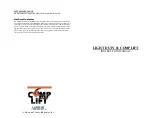
Speidel’s Master Brewer
Page 7 of 26
Speidels Braumeister
act temp T=015°C
prog 1. phase
set time t=005min
Water filled in ?
start
Softening the brewing water
The brewing water can be softened if necessary. The water (cold tap water) is boiled
for 30 minutes in the Master Brewer for this purpose, then it is cooled and stored
temporarily – e.g., in the fermenting container – until the brewing. The separated lime
has been deposited on the bottom of the container and it will be disposed of. The
Master Brewer is designed to brew approximately 20 litres of manufactured beer
(normal beer). Between 25 and 30 litres of brewing water will be required for this
purpose in that case. However, normal (hygienically faultless, colourless and
odourless) cold tap water is also usable for the novice or for the first brewing attempts,
in order to keep the expense and effort somewhat limited at the beginning. The
brewing water should have a hardness of less than 10° dH on principle. The softer the
water, the more suitable it is for brewing.
4.3
Programming / starting the Master Brewer
Connect the Master Brewer. The controls are then in the basic
condition. To programme a recipe and its time and temperature
values, press the ENTER button for 1 sec.
Select the time and temperature with the aid of the ARROW
BUTTONS, confirming each value by pressing the ENTER
button. Programme the mashing, phases 1-5 and the boiling of
the hops. The mode 5 is set to 0 and is only used for special
recipes.
After confirming all programme stages with ENTER, the
display returns to the basic condition. From here, you can now
start the automatic brewing by pressing the START button (1
sec). Now follow the instructions of the programme!
4.4
Mashing (brewing)
The mixing of crushed malt [i.e. grist] and water is described as mashing. The
objective of the entire mashing process is to dissolve the malt starch that is stored in
the malt and to convert it into sugar with the aid of enzymes that are present in the
malt. The various enzymes are effective at different temperatures, which is why the
various temperature stages are then passed through as well.
Mashing
About 23 litres of brewing water is poured into the boiler (up to approx. 2 cm below
the upper marker) first of all. The malt pipe is not installed yet while doing so. The
markers that are fitted on the connecting rod indicate the level of 15 litres, 20 litres
and 25 litres. Confirm that you have added the water by pressing START. This
switches the pump and heating on. The pump switches on and off several times in
order to ventilate it.










































